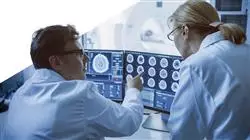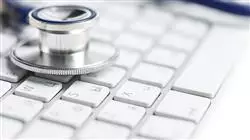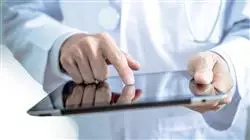University certificate
The world's largest faculty of information technology”
Introduction to the Program
Would you like to specialize in the field of IT applied to E-Health and Big Data? Enroll in this Master's Degree and embark on the path to a successful working future"

Access to more personalized healthcare, tailored to the needs of society and healthcare professionals, is becoming an ever closer reality thanks to the development of E-Health and the application of Big Data in the storage and analysis of information obtained in hospitals, doctors' offices and clinics. This is due, to a greater extent, to the significant leap made by the Internet and digital technologies, favoring connectivity and globalization through increasingly complex, specific and specialized systems.
Today it is possible to monitor patients' vital signs remotely, as well as to treat certain pathologies through virtual reality, all thanks to the work of thousands of computer scientists and engineers who have used their time and talent to create strategies and techniques that have undoubtedly considerably improved healthcare management. For this reason, and in view of the great expectations for the future in this field, TECH Global University has considered it necessary to develop a program through which professionals can learn about this field in detail.
In this way the Professional master’s degree in E-Health and Big Data arises, focused on the IT sector, a complete and comprehensive degree that will allow professionals to specialize in this field in just twelve months through 1,500 hours of the best theoretical and practical training. This is an academic experience with which they will be able to delve into aspects such as bioinformatics computing, the requirements to develop tools for molecular medicine and pathology diagnosis, the creation of biomedical databases or massive information processing.
All this in a 100% online way, from wherever they want and without predefined schedules. This program also includes diverse supplementary material with which students will be able to deepen in a personalized way in the aspects of the syllabus that they consider most important for their work performance. The extensive knowledge of the needs and demands of the health sector will allow them to develop tools and software adapted to the demand, so that the program of this Professional master’s degree will become the vehicle that will lead them to professional success.
Knowing in detail the needs of molecular medicine and pathology diagnostics will allow you to work on the development of specialized strategies and software for E-Health"
This Professional master’s degree in E-Health and Big Data contains the most complete and up-to-date program on the market. The most important features include:
- The development of case studies presented by experts in information and communication technologies focused on the healthcare environment
- The graphic, schematic, and practical contents with which they are created, provide scientific and practical information on the disciplines that are essential for professional practice
- Practical exercises where the self-assessment process can be carried out to improve learning
- Its special emphasis on innovative methodologies
- Theoretical lessons, questions to the expert, debate forums on controversial topics, and individual reflection assignments
- Content that is accessible from any fixed or portable device with an Internet connection
The healthcare sector is increasingly demanding and requiring a qualitative and quantitative leap in E-Health strategies. That is why this program will open many doors for you in the labor market"
The program’s teaching staff includes professionals from the sector who contribute their work experience to this educational program, as well as renowned specialists from leading societies and prestigious universities.
Its multimedia content, developed with the latest educational technology, will allow professionals to learn in a contextual and situated learning environment, i.e., a simulated environment that will provide immersive education programmed to prepare in real situations.
The design of this program focuses on Problem-Based Learning, by means of which professionals must try to solve the different professional practice situations that are presented to them throughout the academic year. For this purpose students will be assisted by an innovative interactive video system developed by renowned experts.
You will be able to delve into the latest aspects of bioinformatics computing through an extensive knowledge of the best search engines and networks"

Do you want to become a reference in the creation and management of biomedical databases? Opt for this Professional master’s degree and start working on it"
Syllabus
The design of this Professional master’s degree has been carried out by the teaching staff, being specialists in cryptoeconomics, they know the latest developments related to successful strategies and the most appropriate protocols to use in each case. In addition, the Relearning methodology has been applied for content development, for which TECH Global University is a pioneer. This is a pedagogical strategy that consists of reiterating the most important concepts throughout the syllabus, so that students receive an academic experience in which they do not have to spend extra hours memorizing, but rather acquire knowledge in a natural and progressive manner.

In the Virtual Campus you will find a multitude of additional high quality material in which you can customize the aspects you consider most important for your professional development"
Module 1. Molecular Medicine and Pathology Diagnosis
1.1. Molecular Medicine
1.1.1. Cellular and Molecular Biology. Cell Injury and Cell Death. Aging
1.1.2. Diseases Caused by Microorganisms and Host Defence
1.1.3. Autoimmune Diseases
1.1.4. Toxicological Diseases
1.1.5. Hypoxia Diseases
1.1.6. Diseases related to the Environment
1.1.7. Genetic Diseases and Epigenetics
1.1.8. Oncological Diseases
1.2. Circulatory System
1.2.1. Anatomy and Function
1.2.2. Myocardial Diseases and Heart Failure
1.2.3. Cardiac Rhythm Diseases
1.2.4. Valvular and Pericardial Diseases
1.2.5. Atherosclerosis, Arteriosclerosis and Arterial Hypertension
1.2.6. Peripheral Arterial and Venous Disease
1.2.7. Lymphatic Disease (Greatly Overlooked)
1.3. Respiratory Diseases
1.3.1. Anatomy and Function
1.3.2. Acute and Chronic Obstructive Pulmonary Diseases
1.3.3. Pleural and Mediastinal Diseases
1.3.4. Infectious Diseases of the Pulmonary Parenchyma and Bronchi
1.3.5. Pulmonary Circulation Diseases
1.4. Digestive System Diseases
1.4.1. Anatomy and Function
1.4.2. Digestive System, Nutrition, and Hydroelectrolyte Exchange
1.4.3. Gastroesophageal Diseases
1.4.4. Gastrointestinal Infectious Diseases
1.4.5. Liver and Biliary Tract Diseases
1.4.6. Pancreatic Diseases
1.4.7. Colon Diseases
1.5. Renal and Urinary Tract Diseases
1.5.1. Anatomy and Function
1.5.2. Kidney failure (Prerenal, Renal, and Postrenal). How they are triggered
1.5.3. Obstructive Urinary Tract Diseases
1.5.4. Sphincteric Insufficiency in the Urinary Tract
1.5.5. Nephrotic Syndrome and Nephritic Syndrome
1.6. Endocrine System Diseases
1.6.1. Anatomy and Function
1.6.2. The Menstrual Cycle and Associated Conditions
1.6.3. Thyroid Disease
1.6.4. Adrenal Insufficiency
1.6.5. Disorders of Sexual Differentiation
1.6.6. Hypothalamic-pituitary Axis, Calcium Metabolism, Vitamin D and its Effects on Growth and Bone System
1.7. Metabolism and Nutrition
1.7.1. Essential and Non-Essential Nutrients: Clarifying Definitions
1.7.2. Carbohydrate Metabolism and Alterations
1.7.3. Protein Metabolism and Alterations
1.7.4. Lipids Metabolism and Alterations
1.7.5. Iron Metabolism and Alterations
1.7.6. Disorders of Acid-Base Balance
1.7.7. Sodium and Potassium Metabolism and Alterations
1.7.8. Nutritional Diseases (Hypercaloric and Hypocaloric)
1.8. Hematologic Diseases
1.8.1. Anatomy and Function
1.8.2. Red Blood Cell Disorders
1.8.3. Diseases of White Blood Cells, Lymph Nodes and Spleen
1.8.4. Hemostasis and Bleeding Diseases
1.9. Musculoskeletal System Diseases
1.9.1. Anatomy and Function
1.9.2. Joints: Types and Function
1.9.3. Bone Regeneration
1.9.4. Normal and Pathological Skeletal System Development
1.9.5. Deformities of the Upper and Lower Limbs
1.9.6. Joint Pathology, Cartilage, and Synovial Fluid Analysis
1.9.7. Joint Diseases with Immunologic Origin
1.10. Nervous System Diseases
1.10.1. Anatomy and Function
1.10.2. Central and Peripheral Nervous System Development
1.10.3. Development of the Spine and Components
1.10.4. Cerebellum and Proprioceptive Diseases
1.10.5. Brain Disorders (Central Nervous System)
1.10.6. Spinal Cord and Cerebrospinal Fluid Diseases
1.10.7. Stenotic Diseases of the Peripheral Nervous System
1.10.8. Infectious Diseases of the Central Nervous System
1.10.9. Cerebrovascular Disease (Stenotic and Hemorrhagic)
Module 2. Health system Management and Administration in Health Centers
2.1. Healthcare Systems
2.1.1. Healthcare Systems
2.1.2. Healthcare Systems according to the WHO
2.1.3. Healthcare Context
2.2. Healthcare Models I. Bismark Model vs. Beveridge Model
2.2.1. Bismark Model
2.2.2. Beveridge Model
2.2.3. Bismark Model Beveridge Model
2.3. Healthcare Models II. Semashko, Private and Mixed Models
2.3.1. Semashko Model
2.3.2. Private Model
2.3.3. Mixed Models
2.4. The Health Market
2.4.1. The Health Market
2.4.2. Health Market Regulation and Limitations
2.4.3. Payment Methods for Doctors and Hospitals
2.4.4. Clinical Engineers
2.5. Hospitals. Typology
2.5.1. Hospital Architecture
2.5.2. Types of Hospitals
2.5.3. Hospital Organization
2.6. Health Metrics
2.6.1. Mortality
2.6.2. Morbidity
2.6.3. Healthy Life Years
2.7. Health Resource Allocation Methods
2.7.1. Lineal Programming
2.7.2. Maximization Models
2.7.3. Minimization Models
2.8. Measuring Healthcare Productivity
2.8.1. Measuring Health Productivity
2.8.2. Productivity Ratios
2.8.3. Input Adjustment
2.8.4. Output Adjustment
2.9. Health Process Improvement
2.9.1. Lean Management Process
2.9.2. Work Simplification Tools
2.9.3. Troubleshooting Tools
2.10. Healthcare Project Management
2.10.1. The Role Played by Project Managers
2.10.2. Team and Project Management Tools
2.10.3. Schedule and Time Management
Module 3. Research in Health Sciences
3.1. Scientific Research I. The Scientific Method
3.1.1. Scientific Research
3.1.2. Research in Health Sciences
3.1.3. The Scientific Method
3.2. Scientific Research II. Typology
3.2.1. Basic Research
3.2.2. Clinical Research
3.2.3. Translational Research
3.3. Evidence-Based Medicine
3.3.1. Evidence-Based Medicine
3.3.2. Principles of Evidence-Based Medicine
3.3.3. Methodology of Evidence-Based Medicine
3.4. Ethics and Legislation in Scientific Research. Declaration of Helsinki
3.4.1. The Ethics Committee
3.4.2. Declaration of Helsinki
3.4.3. Ethics in Health Sciences
3.5. Scientific Research Results
3.5.1. Methods
3.5.2. Rigor and Statistical Power
3.5.3. Scientific Results Validity
3.6. Public Communication
3.6.1. Scientific Societies
3.6.2. Scientific Conferences
3.6.3. Communication Structures
3.7. Funding in Scientific Research
3.7.1. Structure in Scientific Projects
3.7.2. Public Financing
3.7.3. Private and Industrial Funding
3.8. Scientific Resources in Literature Searching. Health Sciences Databases I
3.8.1. PubMed-Medline
3.8.2. Embase
3.8.3. WOS and JCR
3.8.4. Scopus and Scimago
3.8.5. Micromedex
3.8.6. MEDES
3.8.7. IBECS
3.8.8. LILACS
3.8.9. BDENF
3.8.10. Cuidatge
3.8.11. CINAHL
3.8.12. Cuiden Plus
3.8.13. Enfispo
3.8.14. NCBI (OMIM, TOXNET) and NIH (National Cancer Institute) Databases
3.9. Scientific Resources in Literature Searching. Health Sciences Databases II
3.9.1. NARIC - Rehabdata
3.9.2. PEDro
3.9.3. ASABE: Technical Library
3.9.4. CAB Abstracts
3.9.5. Centre for Reviews and Dissemination (CRD) Databases:
3.9.6. Biomed Central BMC
3.9.7. ClinicalTrials.gov
3.9.8. Clinical Trials Register
3.9.9. DOAJ- Directory of Open Access Journals
3.9.10. PROSPERO (Registro Internacional Prospectivo de Revisiones Sistemáticas)
3.9.11. TRIP
3.9.12. LILACS
3.9.13. NIH. Medical Library
3.9.14. Medline Plus
3.9.15. OPS
3.10. Scientific Resources in Literature Searching III. Search Engines and Platforms
3.10.1. Search Engines and Multisearch Engines
3.10.1.1. Findr
3.10.1.2. Dimensions
3.10.1.3. Google Scholar
3.10.1.4. Microsoft Academic
3.10.2. WHO International Clinical Trials Registration Platform (ICTRP)
3.10.2.1. PubMed Central PMC
3.10.2.1. Open Science Collector (RECOLECTA)
3.10.2.2. Zenodo
3.10.3. Doctoral Thesis Search Engines
3.10.3.1. DART-Europe
3.10.3.2. Dialnet
3.10.3.3. OATD (Open Access Theses and Dissertations)
3.10.3.4. TDR (Doctoral Theses Online)
3.10.3.5. TESEO
3.10.4. Bibliography Managers
3.10.4.1. Endnote Online
3.10.4.2. Mendeley
3.10.4.3. Zotero
3.10.4.4. Citeulike
3.10.4.5. Refworks
3.10.5. Digital Social Networks for Researchers
3.10.5.1. Scielo
3.10.5.2. Dialnet
3.10.5.3. Free Medical Journals
3.10.5.4. DOAJ
3.10.5.5. Open Science Directory
3.10.5.6. Redalyc
3.10.5.7. Academia.edu
3.10.5.8. Mendeley
3.10.5.9. ResearchGate
3.10.6. Social Web 2.0. Resources
3.10.6.1. Delicious
3.10.6.2. SlideShare
3.10.6.3. YouTube
3.10.6.4. Twitter
3.10.6.5. Health Science Blogs
3.10.6.6. Facebook
3.10.6.7. Evernote
3.10.6.8. Dropbox
3.10.6.9. Google Drive
3.10.7. Scientific Journal Publishers and Aggregators Portals
3.10.7.1. Science Direct
3.10.7.2. Ovid
3.10.7.3. Springer
3.10.7.4. Wiley
3.10.7.5. Proquest
3.10.7.6. Ebsco
3.10.7.7. BioMed Central
Module 4. Techniques, Recognition and Intervention using Biomedical Imaging
4.1. Medical Imaging
4.1.1. Modalities in Medical Imaging
4.1.2. Objectives in Medical Imaging Systems
4.1.3. Medical Imaging Storage Systems
4.2. Radiology
4.2.1. Imaging Method
4.2.2. Radiology Interpretation
4.2.3. Clinical Applications
4.3. Computed Tomography (CT)
4.3.1. Principle of Operation
4.3.2. Image Generation and Acquisition
4.3.3. Computerized Tomography. Typology
4.3.4. Clinical Applications
4.4. Magnetic Resonance Imaging (MRI)
4.4.1. Principle of Operation
4.4.2. Image Generation and Acquisition
4.4.3. Clinical Applications
4.5. Ultrasound: Ultrasound and Doppler Sonography
4.5.1. Principle of Operation
4.5.2. Image Generation and Acquisition
4.5.3. Typology
4.5.4. Clinical Applications
4.6. Nuclear medicine
4.6.1. Physiological Basis in Nuclear Studies. (Radiopharmaceuticals and Nuclear Medicine)
4.6.2. Image Generation and Acquisition
4.6.3. Types of Tests
4.6.3.1. Gammagraphy
4.6.3.2. SPECT
4.6.3.3. PET:
4.6.3.4. Clinical Applications
4.7. Image-Guided Interventions
4.7.1. Interventional Radiology
4.7.2. Interventional Radiology Objectives
4.7.3. Procedures
4.7.4. Advantages and Disadvantages
4.8. Image Quality
4.8.1. Technique
4.8.2. Contrast
4.8.3. Resolution
4.8.4. Noise
4.8.5. Distortion and Artifacts
4.9. Medical Imaging Tests. Biomedicine
4.9.1. Creating 3D Images
4.9.2. Biomodels
4.9.2.1. DICOM Standard
4.9.2.2. Clinical Applications
4.10. Radiological Protection
4.10.1. European Legislation Applicable to Radiology Services
4.10.2. Safety and Action Protocols
4.10.3. Radiological Waste Management
4.10.4. Radiological Protection
4.10.5. Care and Characteristics of Rooms
Module 5. Computation in Bioinformatics
5.1. Central Tenet in Bioinformatics and Computing. Current State
5.1.1. The Ideal Application in Bioinformatics
5.1.2. Parallel Developments in Molecular Biology and Computing
5.1.3. Dogma in Biology and Information Theory
5.1.4. Information Flows
5.2. Databases for Bioinformatics Computing
5.2.1. Database
5.2.2. Data management
5.2.3. Data Life Cycle in Bioinformatics
5.2.3.1. Use
5.2.3.2. Modifications
5.2.3.3. Archive
5.2.3.4. Reuse
5.2.3.5. Discarded
5.2.4. Database Technology in Bioinformatics
5.2.4.1. Architecture
5.2.4.2. Database Management
5.2.5. Interfaces for Bioinformatics Databases
5.3. Networks for Bioinformatics Computing
5.3.1. Communication Models. LAN, WAN, MAN and PAN Networks
5.3.2. Protocols and Data Transmission
5.3.3. Network Topologies
5.3.4. Datacenter Hardware for Computing
5.3.5. Security, Management and Implementation
5.4. Search Engines in Bioinformatics
5.4.1. Search Engines in Bioinformatics
5.4.2. Search Engine Processes and Technologies in Bioinformatics
5.4.3. Computational Models: Search and Approximation Algorithms
5.5. Data Display in Bioinformatics
5.5.1. Displaying Biological Sequences
5.5.2. Displaying Biological Structures
5.5.2.1. Visualization Tools
5.5.2.2. Rendering Tools
5.5.3. User Interface in Bioinformatics Applications
5.5.4. Information Architectures for Displays in Bioinformatics
5.6. Statistics for Computing
5.6.1. Statistical Concepts for Computing in Bioinformatics
5.6.2. Use Case: MARN Microarrays
5.6.3. Imperfect Data. Statistical Errors: Randomness, Approximation, Noise and Assumptions
5.6.4. Error Quantification: Precision and Sensitivity
5.6.5. Clustering and Classification
5.7. Data Mining
5.7.1. Mining and Data Computing Methods
5.7.2. Infrastructure for Data Mining and Computing
5.7.3. Pattern Discovery and Recognition
5.7.4. Machine Learning and New Tools
5.8. Genetic Pattern Matching
5.8.1. Genetic Pattern Matching
5.8.2. Computational Methods for Sequence Alignments
5.8.3. Pattern Matching Tools
5.9. Modelling and Simulation
5.9.1. Use in the Pharmaceutical Field: Drug Discovery
5.9.2. Protein Structure and Systems Biology
5.9.3. Available Tools and Future
5.10. Collaboration and Online Computing Projects
5.10.1. Grid Computing
5.10.2. Standards and Rules Uniformity, Consistency and Interoperability
5.10.3. Collaborative Computing Projects
Module 6. Biomedical Databases
6.1. Biomedical Databases
6.1.1. Biomedical Databases
6.1.2. Primary and Secondary Databases
6.1.3. Major Databases
6.2. DNA Databases
6.2.1. Genome Databases
6.2.2. Gene Databases
6.2.3. Mutations and Polymorphisms Databases
6.3. Protein Databases
6.3.1. Primary Sequence Databases
6.3.2. Secondary Sequence and Domain Databases
6.3.3. Macromolecular Structure Databases
6.4. Omics Projects Databases
6.4.1. Genomics Studies Databases
6.4.2. Transcriptomics Studies Databases
6.4.3. Proteomics Studies Databases
6.5. Genetic Diseases Databases. Personalized and Precision Medicine
6.5.1. Genetic Diseases Databases
6.5.2. Precision Medicine. The Need to Integrate Genetic Data
6.5.3. Extracting Data from OMIM
6.6. Self-Reported Patient Repositories
6.6.1. Secondary Data Use
6.6.2. Patients' Role in Deposited Data Management
6.6.3. Repositories of Self-Reported Questionnaires. Examples:
6.7. Elixir Open Databases
6.7.1. Elixir Open Databases
6.7.2. Databases Collected on the Elixir Platform
6.7.3. Criteria for Choosing between Databases
6.8. Adverse Drug Reactions (ADRs) Databases
6.8.1. Pharmacological Development Processes
6.8.2. Adverse Drug Reaction Reporting
6.8.3. Adverse Reaction Repositories at European and International Levels
6.9. Research Data Management Plans. Data to be Deposited in Public Databases
6.9.1. Data Management Plans
6.9.2. Data Custody in Research
6.9.3. Data Entry in Public Databases
6.10. Clinical Databases. Problems with Secondary Use of Health Data
6.10.1. Medical Record Repositories
6.10.2. Data Encryption
Module 7. Big Data in Medicine: Massive Medical Data Processing
7.1. Big Data in Biomedical Research
7.1.1. Data Generation in Biomedicine
7.1.2. High-Throughput Technology
7.1.3. Uses of High-Throughput Data. Hypotheses in the Age of Big Data
7.2. Data Pre-Processing in Big Data
7.2.1. Data Pre-Processing
7.2.2. Methods and Approaches
7.2.3. Problems with Data Pre-Processing in Big Data
7.3. Structural Genomics
7.3.1. Sequencing the Human Genome
7.3.2. Sequencing vs. Chips
7.3.3. Variant Discovery
7.4. Functional Genomics
7.4.1. Functional Notation
7.4.2. Mutation Risk Predictors
7.4.3. Association Studies in Genomics
7.5. Transcriptomics
7.5.1. Techniques to Obtain Massive Data in Transcriptomics: RNA-seq
7.5.2. Data Normalization in Transcriptomics
7.5.3. Differential Expression Studies
7.6. Interactomics and Epigenomics
7.6.1. The Role of Cromatine in Gene Expression
7.6.2. High-Throughput Studies in Interactomics
7.6.3. High-Throughput Studies in Epigenetics
7.7. Proteomics
7.7.1. Analysis of Mass Spectrometry Data
7.7.2. Post-Translational Modifications Study
7.7.3. Quantitative Proteomics
7.8. Enrichment and Clustering Techniques
7.8.1. Contextualizing Results
7.8.2. Clustering Algorithms in Omics Techniques
7.8.3. Repositories for Enrichment: Gene Ontology and KEGG
7.9. Applying Big Data to Public Health
7.9.1. Discovery of New Biomarkers and Therapeutic Targets
7.9.2. Risk Predictors
7.9.3. Personalized Medicine
7.10. Big Data Applied to Medicine
7.10.1. Potential for Diagnostic and Preventive Assistance
7.10.2. Use of Machine Learning Algorithms in Public Health
7.10.3. The Problem of Privacy
Module 8. Applications of Artificial Intelligence and the Internet of Things (IoT) in Telemedicine
8.1. E-Health Platforms. Personalizing Healthcare Services
8.1.1. E-Health Platform
8.1.2. Resources for E-Health Platforms
8.1.3. Digital Europe Program. Digital Europe-4-Health and Horizon Europe
8.2. Artificial Intelligence in the Healthcare Field I: New Solutions in Computer Applications
8.2.1. Remote Analysis of Results
8.2.2. Chatbox
8.2.3. Prevention and Real-Time Monitoring
8.2.4. Preventive and Personalized Medicine in Oncology
8.3. Artificial Intelligence in Healthcare II:
8.3.1. Monitoring Patients with Reduced Mobility
8.3.2. Cardiac Monitoring, Diabetes, Asthma
8.3.3. Health and Wellness Apps
8.3.3.1. Heart Rate Monitors
8.3.3.2. Blood Pressure Bracelets
8.3.4. Ethical Use of AI in the Medical Field. Data Protection
8.4. Artificial Intelligence Algorithms for Image Processing
8.4.1. Artificial Intelligence Algorithms for Image Handling
8.4.2. Image Diagnosis and Monitoring in Telemedicine
8.4.2.1. Melanoma Diagnosis
8.4.3. Limitations and Challenges in Image Processing in Telemedicine
8.5. Application Acceleration using Graphics Processing Units (GPU) in Medicine
8.5.1. Program Parallelization
8.5.2. GPU Operations
8.5.3. Application Acceleration using GPU in Medicine
8.6. Natural Language Processing (NLP) in Telemedicine
8.6.1. Text Processing in the Medical Field. Methodology
8.6.2. Natural Language Processing in Therapy and Medical Records
8.6.3. Limitations and Challenges in Natural Language Processing in Telemedicine
8.7. The Internet of Things (IoT) in Telemedicine. Applications
8.7.1. Monitoring Vital Signs. Wearables
8.7.1.1. Blood Pressure, Temperature, and Heart Rate
8.7.2. The IoT and Cloud Technology
8.7.2.1. Data Transmission to the Cloud
8.7.3. Self-Service Terminals
8.8. IoT in Patient Monitoring and Care
8.8.1. IoT Applications for Emergency Detection
8.8.2. The Internet of Things in Patient Rehabilitation
8.8.3. Artificial Intelligence Support in Victim Recognition and Rescue
8.9. Nanorobots. Typology
8.9.1. Nanotechnology
8.9.2. Types of Nanorobots
8.9.2.1. Assemblers. Applications
8.9.2.2. Self-Replicating. Applications
8.10. Artificial Intelligence in COVID-19 Control
8.10.1. COVID-19 and Telemedicine
8.10.2. Management and Communication of Breakthroughs and Outbreaks
8.10.3. Outbreak Prediction in Artificial Intelligence
Module 9. Telemedicine and Medical, Surgical and Biomechanical Devices
9.1. Telemedicine and Telehealth
9.1.1. Telemedicine as a Telehealth Service
9.1.2. Telemedicine
9.1.2.1. Telemedicine Objectives
9.1.2.2. Benefits and Limitations of Telemedicine
9.1.3. Digital Health. Technologies
9.2. Telemedicine Systems
9.2.1. Components in Telemedicine Systems
9.2.1.1. Personal
9.2.1.2. Technology
9.2.2. Information and Communication Technologies (ICT) in the Health Sector
9.2.2.1. t-Health
9.2.2.2. mHealth
9.2.2.3. u-Health
9.2.2.4. p-Health
9.2.3. Telemedicine Systems Assessment
9.3. Technology Infrastructure in Telemedicine
9.3.1. Public Switched Telephone Network (PSTN)
9.3.2. Satellite Networks
9.3.3. Integrated Services Digital Network (ISDN)
9.3.4. Wireless Technology
9.3.4.1. WAP. Wireless Application Protocol
9.3.4.2. Bluetooth
9.3.5. Microwave Connections
9.3.6. ATM Asynchronous Transfer Mode
9.4. Types of Telemedicine. Uses in Healthcare
9.4.1. Remote Patient Monitoring
9.4.2. Storage and Shipping Technologies
9.4.3. Interactive Telemedicine
9.5. Telemedicine: General Applications
9.5.1. Telecare
9.5.2. Telemonitoring
9.5.3. Telediagnostics
9.5.4. Teleeducation
9.5.5. Telemanagement
9.6. Telemedicine: Clinical Applications
9.6.1. Teleradiology
9.6.2. Teledermatology
9.6.3. Teleoncology
9.6.4. Telepsychiatry
9.6.5. Telehome-care
9.7. Smart Technologies and Care
9.7.1. Integrating Smart Homes
9.7.2. Digital Health to Improve Treatment
9.7.3. Telehealth Clothing Technology. “Smart Clothes”
9.8. Ethical and Legal Aspects of Telemedicine
9.8.1. Ethical Foundations
9.8.2. Common Regulatory Frameworks
9.8.4. ISO Standards
9.9. Telemedicine and Diagnostic, Surgical and Biomechanical Devices
9.9.1. Diagnostic Devices
9.9.2. Surgical Devices
9.9.2. Biomechanic Devices
9.10. Telemedicine and Medical Devices
9.10.1. Medical Devices
9.10.1.1. Mobile Medical Devices
9.10.1.2. Telemedicine Carts
9.10.1.3. Telemedicine Kiosks
9.10.1.4. Digital Cameras
9.10.1.5. Telemedicine Kit
9.10.1.6. Telemedicine Software
Module 10. Business Innovation and Entrepreneurship in E-Health
10.1. Entrepreneurship and Innovation
10.1.1. Innovation
10.1.2. Entrepreneurship
10.1.3. Startups
10.2. Entrepreneurship in E-Health
10.2.1. Innovative E-Health Market
10.2.2. Verticals in e-Health: mHealth
10.2.3. TeleHealth
10.3. Business Models I: First Stages in Entrepreneurship
10.3.1. Types of Business Models
10.3.1.1. Marketplaces
10.3.1.2. Digital Platforms
10.3.1.3. Saas
10.3.2. Critical Elements in the Initial Phase. The Business Idea
10.3.3. Common Mistakes in the First Stages of Entrepreneurship
10.4. Business Models II: Canvas Model
10.4.1. Canvas Business Model
10.4.2. Value proposition
10.4.3. Key Activities and Resources
10.4.4. Customer Segments
10.4.5. Customer Relationships
10.4.6. Distribution Channels
10.4.7. Partnerships
10.4.7.1. Cost Structure and Revenue Streams
10.5. Business Models III: Lean Startup Methodology
10.5.1. Create
10.5.2. Validate
10.5.3. Measure
10.5.4. Decide
10.6. Business Models IV: External, Strategic and Regulatory Analysis
10.6.1. Red Ocean and Blue Ocean Strategies
10.6.2. Value Curves
10.6.3. Applicable E-Health Regulations
10.7. Successful E-Health Models I: Knowing Before Innovating
10.7.1. Analysis of Successful E-Health Companies
10.7.2. Analysis of Company X
10.7.3. Analysis of Company Y
10.7.4. Analysis of Company Z
10.8. Successful E-Health Models II: Listening before Innovating
10.8.1. Practical Interview: e-Health Startup CEO
10.8.2. Practical Interview: "Sector X" Startup CEO
10.8.3. Practical Interview: "Startup X" Technical Management
10.9. Entrepreneurial Environment and Funding
10.9.1. Entrepreneur Ecosystems in the Health Sector
10.9.2. Financing
10.9.3. Funding
10.10. Practical Tools in Entrepreneurship and Innovation
10.10.1. Open-Source Intelligence (OSINT)
10.10.2. Analysis
10.10.3. No-Code Tools in Entrepreneurship

Don't hesitate any longer and opt for a degree that, in addition to giving you the keys to succeed in the field of bioinformatics, will give you the key to undertake your own projects in E-Health with guaranteed success"
Professional Master's Degree in E-Health and Big Data
Dive into the exciting world of technology applied to healthcare with the Master's Degree in E-Health and Big Data from TECH Global University. Discover how informatics and data analysis are transforming the healthcare sector and improving people's quality of life. Today, digitization and the use of advanced technologies are revolutionizing the way healthcare services are delivered. With our Professional Master's Degree ,you will learn how to develop innovative solutions that optimize medical processes and improve patient care. The program is taught through online classes, which gives you the flexibility to study from anywhere and adapt your schedule to your needs. At TECH Global University, we are proud to offer a high quality online educational experience. You will have expert professors in the field of health informatics to guide you throughout your learning. In addition, you will have access to up-to-date teaching resources and state-of-the-art technological tools that will enrich your learning experience.
Use technology in favor of health
The Professional Master's Degree in E-Health and Big Data focuses on the application of information technologies and the analysis of large volumes of data in the field of healthcare. You will learn how to use data processing tools and techniques to extract relevant information that contributes to clinical decision-making and the improvement of healthcare services. In addition, you will explore topics such as health system interoperability, medical information security, telemedicine and artificial intelligence in healthcare. You will be prepared to face technological challenges and lead the digital transformation in the healthcare sector. If you are passionate about technology and want to contribute to the advancement of healthcare using informatics tools and data analysis, our Professional Master's Degree in E-Health and Big Data is your path to professional success. Enroll in TECH Global University and become an expert in the convergence between informatics and healthcare!!!







